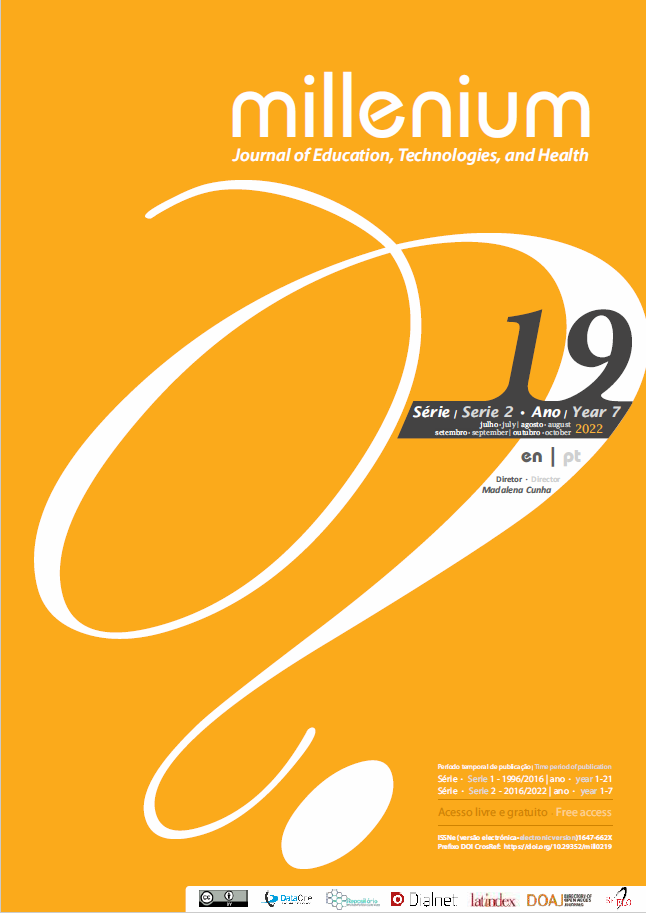Cuidados de enfermagem na transferência inter-hospitalar de doentes críticos
protocolo de uma revisão de scoping
DOI:
https://doi.org/10.29352/mill0219.27123Palavras-chave:
doente crítico, transporte inter-hospitalar, transferências de pacientes, checklist, guidelinesResumo
Introdução: Durante o transporte inter-hospitalar de doentes críticos, os enfermeiros são responsáveis por manter a segurança e qualidade dos cuidados prestados pelo que devem ter acesso a informação clínica precisa e de forma rápida.
Objectivo: Mapear quais os itens que devem integrar uma checklist de acompanhamento do doente crítico no transporte inter-hospitalar.
Métodos: Será realizada uma revisão de acordo com as últimas diretrizes da metodologia do Instituto Joanna Briggs (J.B.I.). Vai ser efetuada uma pesquisa em bases de dados electrónicas relevantes e em literatura cinzenta utilizando termos, segundo os DeCS, tais como "doente crítico", “transporte inter-hospitalar”, “transferência de pacientes”, “checklist” e “diretrizes”.
Resultados: Esta revisão considerará qualquer tipo de estudo quantitativo, qualitativo e de métodos mistos, concentrando-se em itens a incluir numa checklist para acompanhar/monitorizar o doente crítico durante o transporte inter-hospitalar.
Conclusão: O desenvolvimento e implementação de uma checklist do transporte inter-hospitalar permite a segurança durante a transferência dos doentes críticos. Os enfermeiros são profissionais de saúde que acompanham maioritariamente os doentes críticos nas transferências entre as diferentes unidades hospitalares. Este protocolo está registado no Open Science Framework.
Downloads
Referências
Association of Anaesthetists of Great Britain and Ireland (2009). Safety Guideline: Interhospital Transfer. pp. 1-20. Retrieved from: https://anaesthetists.org/Home/Resources-publications/Guidelines/Interhospital-transfer-AAGBI-safety-guideline
Australasian College for Emergency Medicine., Australian and New Zealand College of Anaesthetists., College of Intensive Care Medicine of Australian and New Zealand (2015). Guidelines for transport of critically ill patients. Victoria: Australian and New Zealand College of Anaesthetists. Retrieved from: https://www.anzca.edu.au/getattachment/bd5938d2-d3ab-4546-a6b0-014b11b99b2f/PS52-Guideline-for-transport-of-critically-ill-patients
Comeau, Y., Armendariz-Batiste, J., & Woodby, A. (2015). Safety first! Using a checklist for intrafacility transport of adult intensive care patients. Critical care nurse, 35, 16-25. http://doi.org/10.4037/ccn2015991
Hales, B., Terblanche, M., Fowler, R., & Sibbald, W. (2008). Development of medical checklists for improved quality of patient care. International Journal for Quality in Health Care, 20, 22-30. https://pubmed.ncbi.nlm.nih.gov/18073269/
Intensive Care Society (2002). Guidance On: The Transfer of the Critically Adult.
Intensive Care Society (2019). Guidance On: The Transfer of the Critically Ill Adult. pp. 1-40. Retrieved from: https://www.ficm.ac.uk/sites/default/files/transfer_criti-cally_ill_adult_2019.pdf
Kulshrestha, A., & Singh, J. (2016). Inter-hospital and intra-hospital patient transfer: Recent concepts. Indian Journal of Anaesthesia, 60, 13-19. https://pubmed.ncbi.nlm.nih.gov/27512159/
National Health Service. (2021). Framework to support inter-hospital transfer of critical care patients. pp. 1-4. Retrieved from: https://www.england.nhs.uk/wp-content/uploads/2021/12/B1215-framework-to-support-inter-hospital-transfer-of-critical-care-patients.pdf
Ordem dos Médicos e Sociedade Portuguesa de Cuidados Intensivos. (2008). Transporte de Doentes Críticos – Recomendações. Centro Editor Livreiro da Ordem dos Médicos. Retrieved from: https://www.spci.pt/media/documentos/15827260365e567b9411425.pdf
Downloads
Publicado
Como Citar
Edição
Secção
Licença
Direitos de Autor (c) 2022 Millenium - Journal of Education, Technologies, and Health

Este trabalho encontra-se publicado com a Licença Internacional Creative Commons Atribuição 4.0.
Os autores que submetem propostas para esta revista concordam com os seguintes termos:
a) Os artigos são publicados segundo a licença Licença Creative Commons (CC BY 4.0), conformando regime open-access, sem qualquer custo para o autor ou para o leitor;
b) Os autores conservam os direitos de autor e concedem à revista o direito de primeira publicação, permitindo-se a partilha livre do trabalho, desde que seja corretamente atribuída a autoria e publicação inicial nesta revista.
c) Os autores têm autorização para assumir contratos adicionais separadamente, para distribuição não-exclusiva da versão do trabalho publicada nesta revista (ex.: publicar em repositório institucional ou como capítulo de livro), com reconhecimento de autoria e publicação inicial nesta revista.
d) Os autores têm permissão e são estimulados a publicar e distribuir o seu trabalho online (ex.: em repositórios institucionais ou na sua página pessoal) já que isso pode gerar alterações produtivas, bem como aumentar o impacto e a citação do trabalho publica
Documentos necessários à submissão
Template do artigo (formato editável)





